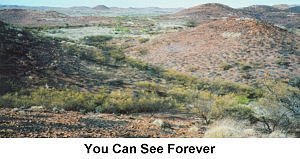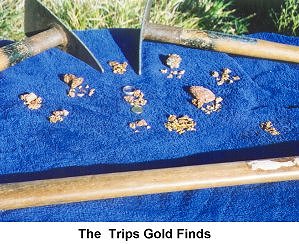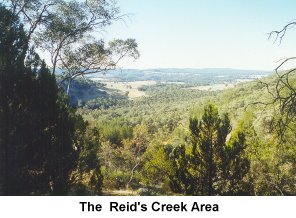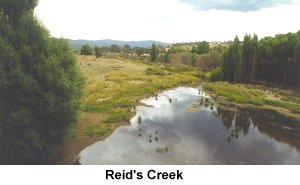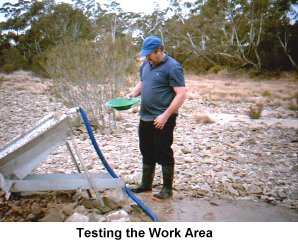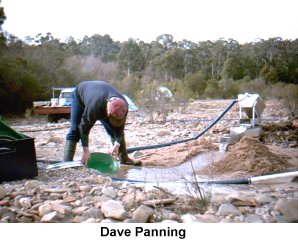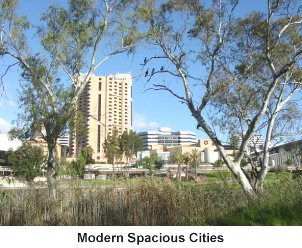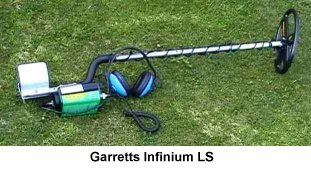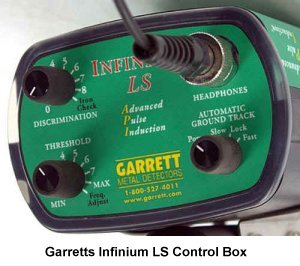
| August 2002 | ||||||||||||||||||||||||||||||||||||||||||||||||||||||||||||||||
|
||||||||||||||||||||||||||||||||||||||||||||||||||||||||||||||||
Contents
|
||||||||||||||||||||||||||||||||||||||||||||||||||||||||||||||||
1. EDITORIAL It had been good to see that Garrett have finally released their new Infinium LS Detector. There has been a great deal said about this new product on the market for detectorists. No doubt the discerning public will eventually dictate the success or otherwise of this product. Gold Net Australia welcomes new products to the market place - where any enhancement of recovery facilities to gain more gold from the goldfields is always a positive step. We wish Garrett well with their new detector. The gold price seems to have settled back towards the US$300 mark. The fluctuating price in recent months has stimulated corporate interest in bullion stocks and we have had a number of contacts relating to large gold sales. One enquiry was for 12 tons of gold. Coiltek are expanding their horizons - and will soon open new premises in Maryborough, Victoria. Next month we will bring you the full story of their expansion plans. It is good to see some faith being shown in the future of the gold prospecting industry.
Gold Net Australia welcomes stories submitted for publication by amateur detectorists and visitors to this country. Editor Email: [email protected]
All material in this magazine is copyright and may not be reproduced in any part or form whatsoever without written permission from the publisher.
|
||||||||||||||||||||||||||||||||||||||||||||||||||||||||||||||||
2. AUSTRALIA LAND OF MY DREAMS PT 2
 by Fred Mason Thursday, last day of the tour and I was still hoping for the BIG ONE. I was a little desperate to make a great find, or at least more little nuggets. Gold is the reason we are swinging the coil, listening for that deep, faint sound that will turn into the mother of all nuggets. Well, patience and determination are good traits for a gold hunter, desperation is not. I have rarely found gold when I got greedy (desperate) for the yellow rocks. Nonetheless, I was determined to keep at it to the bitter end. So, after the morning hunt I had Orlando drop me off a few miles from camp. I would work my way back to camp. Along the way I was startled by two kangaroos that burst out of the brush within thirty feet of me. They are wondrous animals, bounding over the terrain on two legs and a big tail. What a sight! One of the things I enjoy about nugget hunting is that I can look around and enjoy the beauty of the landscape where ever I may be. As I hunted my way back to camp I realized my state of mind was not allowing me to pay proper attention to the call of the nuggets. So I decided to head back to camp and enjoy the afternoon with my gold-mates, and a beer, or two.
The next morning everyone packed and said their goodbyes. All the people with gas powered vehicles headed back to Nullagine to hopefully fill their tanks. The gas delivery had not arrived on time and several of our group were counting on filling up in Nullagine as they had passed on the available fuel in Marble Bar because they thought the price was too high. (Australians can be a bit thrifty.) The Outback delivery system is a bit unpredictable-never pass up an opportunity to top off your fuel tanks, you can be stranded for a very long time in the vast empty spaces of Western Australia. After Doug finished his business in Nullagine, we set off to meet up with Larry B.at Melrose Station, a huge sheep ranch in the southern part of Western Australia. We traveled all day on washboard roads at 40 or 50 miles per hour. Most of the roads in W. A. are not paved and maintenance is sparse. The basic mode is to take the middle of the road and play chicken with oncoming vehicles if they are your size however, always yield to the Road Trains they will always win! We drove all day heading south and only seen four or five vehicles the entire day. I was thrilled to pass through so much of W.A. and see geography, plants and animals I have read about through the years. It is a long way to anywhere from Nullagine, some time midday we stopped at the roadhouse near the Tropic of Capricorn. We spent the night camped out on the side of the road. Doug and Orlando scrapped some odd bits together and called them "tea" while Peter and I made a fire. I always was amazed at the casual use of cooking fires in the Outback. When the Aussies decided to make tea they would pull the car over, kick some sticks together and have a fire. Then they would drive off and leave with little concern�this was very different then fire use in the States, but has been a practice for ages long past, no criticism intended, mates. The next day we arrived in Meekatharra and Doug decided to do some footwork for future tours. After we set up in a caravan park we went detecting. The place where we stopped was covered with ironstone, even more then the usual. However I managed a half gram bit and Orlando found ironstone with quartz and a little gold. He was not thrilled with it but I was fascinated with it. To me that piece of ironstone/quartz/gold rock is the embodiment of Australian Gold Hunting. I badly wanted to find my own piece but had not, so I bought Orlando's piece in case I failed in my quest. Monday morning we arrived in Lenester, did some shopping, and headed out to meet Larry B. I was more anxious about this phase of my trip because I would be left alone with a total stranger with whom I would have to spend the next ten days in close proximity�I have never been known as the most social, or talkative, guy so this would be very difficult for me. Along the way Doug told me Larry was not very talkative, especially in the morning. Boy, was Doug misinformed! I made the mistake of telling Larry what Doug had said about him not being a talker and he then made every effort to prove Doug wrong.
As we were driving about, I saw the tail of a goanna lizard as the goanna went into it's borrow. Unfortunately the weather turned very cool and I could not find any snakes or lizards as I detected along. I really wanted to see a death adder, brown snake and some of the big lizards, but fall is not the best time for reptiles. Maybe next time. I did see many more Emus and Kangaroos in southern Western Australia then in the Pilbara. I was fascinated and thrilled at every sighting of each animal while in Australia.
Every day I was with Larry he tried to teach or show me some new aspect of Australian Gold Hunting. The tales Larry told and the knowledge he has were both beyond my comprehension, what an exciting way to earn a living. I am grateful to Larry for his patience with me, and for his efforts to get me onto the gold.
Friday - travel day Would I go again? You bet!
|
||||||||||||||||||||||||||||||||||||||||||||||||||||||||||||||||
|
||||||||||||||||||||||||||||||||||||||||||||||||||||||||||||||||
3. WOOLSHED VALLEY by Sue "Goldie" Reynolds One of the most picturesque auriferous places in Victoria is the Beechworth area, in the north east of the State - just west of the Great Dividing Range. The drive west to Eldorado from Beechworth is indeed a most pleasurable experience. Among the many picturesque valleys in this region lies the Woolshed Valley, through which Reid's Creek runs. This most tranquil scene took the early settlers eye, with the meandering creek winding its way across the valley floor. Coupled with the fact that it was highly auriferous soon made Woolshed Valley a very popular place indeed.
Reid and his partners decided not to go to California - and three years later gold was discovered officially at Reid's Creek. When he discussed selling and leaving he could not have considered that he was resting on over 10 tons of gold, hidden in the banks of the creek, at Woolshed Flat.
The opening up of this gold field was essentially the work of one man, named Johnson. He had been working the upper reaches in 1853 accurately predicted that further down Reid's Creek, there would be a large amount of gold.
He employed 4 men and began to dig. Amazingly, after selecting what he thought would be the best area - he ran out of funds without finding any gold. Once news of the find spread, the area was flooded with diggers. The finds were spectacular. One man found 20 pounds of gold in one pocket. Four men found 84 ounces in a day. Two men found 60 ounces and three found 30 ounces. One man was lucky enough to find over 120 pounds in 2 weeks.
Some of the wash dirt from Reid's Creek returned as much as 7 pounds of gold from just 9 dishes of dirt. These were spectacular results in any man's language. Perhaps the most gold recorded as being recovered from this area was 5,000 ounces for a weeks work. Just how much gold really came from this area is anyone's guess - but a figure of 10 tons is a very conservative and more likely at least double that amount. Most, who held claims along Reid's Creek, walked away extremely wealthy men. The area was so rich that an average claim was just 8 feet by 8 feet.
One enterprising group found that the area they were trying to dig from - was unable to be isolated from the creek - so they began ti pick the tufts of grass from the banks of the creek, and as soon as they did - the gold could be seen shining throughout - and their gold recovery was from that time on mainly about lifting the grass from the banks of the creek. Nuggets were rare in these creeks and their tributaries, with most of the gold found in the black sand - which of course turned out to be tin ore. Recovery of gold was rather easy here as it shone out in the black sand. The gold here was in general extremely fine, and easily extracted when washed. A few years later in 1857 - a little further to the east but still within the Ovens Gold field the Chinese riots occurred at the Buckland. It speaks volumes that from 1853 until 1857 this gold field was producing excellent quantities of gold. Additionally, further dredging in the 1930's further west at El Dorado a huge quantity of gold and tin was recovered from the broad stretches of the lower reaches of Reid's Creek. In fact even at this time, more than 2 tons of gold was recovered from the creek.
The Reid's Creek area was in fact clearly the richest creek in the Victorian Gold fields. No doubt large quantities of gold still remain encapsulated within the ground in this area. Most of this ground is now privately held and recovery no longer possible. Many stories of this extensive gold field are left to be told - but then that will be for another day.
|
||||||||||||||||||||||||||||||||||||||||||||||||||||||||||||||||
|
||||||||||||||||||||||||||||||||||||||||||||||||||||||||||||||||
4. THE ALLUVIAL PROSPECTOR by Jim Bowman The June long weekend was now upon us! The ute is loaded ready for the next big adventure. The weather in Queanbeyan NSW is not the brightest with heavy overcast sky's and the forecast of rain for Saturday. All in all it should be an interesting long weekend. As it turned out it was not the rain but the wind that was the main concern for 3 days and two nights. It was unremitting but it did not deter us from our quest. Upon arrival at our destination it was decided that Saturday would be the day we set aside to test the area and find were we where going to work. It always pays to spend time to check the area out before you set your gear up and this is exactly what we did. A few high river banks were the first place of interest to us but they only gave 7 specks per pan and would not be viable to work with the Banjos at this point in time. We moved slowly down to the sand flats which cover around a hundred metres or so testing all the time. At one area I came to a spot amongst wattle trees which gave me a return of 60 to 100 specks per pan consistently over a 10 metre square and the gold ran a little over 20 cm deep.
I decided to set up at the Wattle trees first and work that area then move down to the river gutter for the rest of the time. It really surprises me that people dig the trees out thinking that the best gold is under them, if they only take the time and test pan they would find out the best gold is. In fact one to two metres down stream of the trees and not under them. By this stage it was lunch time and time to set camp. The five of us decided to make camp behind a rather large sand bank which was covered by vegetation and should give us a small amount of shelter from the wind. Now setting small dome tents on sand on a windy day is a good challenge for any serious camper. I can assure you of that. But the trick is to have with you small timber that will slide through the tents anchor points and then you place large rocks on the timber which holds the tent in place. If you try and peg it down, the pegs just pull straight out of the sand. We found the timber and rocks are the best way to hold the tent down.
Sunday arrived still very windy but an early start was made on the river gutter. 4 Banjos were lined up across and around the river gutter. The gutter is around 6 metres wide, which meant each man had a two metre stretch to dig. The way we worked was like this. We build a small pad for the Banjos to sit on then we worked forward back-filling our holes as we went. It is a good way to work for the ground you are about to work is keep clear. At times we see follow prospectors working away happily throwing rocks over un-worked ground they soon find out when they need to change direction just what a mistake that is! The distance we had to pump to this spot was around 80 metres. I was using one and a half inch hose, out of a Honda 2.5 motor fitted with a pump which has a two inch inlet and a one and a half inch outlet all our pumps are the same. The returns we were getting was around a gram of gold per metre of processed sand, which is very good. At 3 pm a halt was decided upon, for the wind and cold were starting to get to us. Back to camp for some well earned rest and a warming by the fire. Monday would have to be the worst of the 3 days in regards to the weather. But it was back to the river gutter for a few more hours work before returning to break camp. All in all we had a very profitable time. Tthe only down side was the weather, but you must take the good with the bad. After all that is what prospecting is all about! Note when I done my final clean up of the gold concentrates at home, the total weight of my finds was 8.4 grams. Had the weather been kinder to us I am sure the end total would have been around a half ounce.
|
||||||||||||||||||||||||||||||||||||||||||||||||||||||||||||||||
|
||||||||||||||||||||||||||||||||||||||||||||||||||||||||||||||||
|
5. WE ARE AUSTRALIA - PART 4  by Brad Williams During the latter part of the 20th century - Australia became of age. Up until the 1970's Australia was still essentially a white society, except for the indigenous population, who were treated as second class citizens. In the last 30 yrs many sociological changes have occurred in Australia. Aborigines can now vote. The white Australia policy has been abandoned and the acceptance of other cultures on non white background has been introduced.
In recent years the refugee intakes from global conflicts, and from politically sensitive areas, such as Iran, Iraq and Afghanistan have accelerated rapidly. In many respects, these immigrants have enriched the face and life of Australia. The restaurants and food choices have exploded. Pizza, Chinese, Thai, Indian, Vietnamese, Mexican, and Creek restaurants, provide a vast array of different choices.
Of course - there are down sides - as there are with any ethnic groups.
Asian crime gangs so exist - as do elements of the Mafia. Overall, however the vast majority of immigrants are simply people wanting a better way of life and who are in the main prepared to accept the wonderful way of life that Australia offers.
Although considered a middle military power within the region, the population of only 20 million spread over a continent almost the size of the continental USA, leaves a lot of growth potential to still be realised.
Yet in Western Australia Perth is the most remote capital city on Earth.
With a population of just over 1 million the next nearest capital city in Australia is Adelaide, South Australia, almost 2,000 miles to the east.
Australia's greatest population base is in the major cities. Each State has a capital city which dominates the population of each state. Australians are an inventive lot. Among the inventions credited are:
Discovery of Aspro (Aspirin) These are just a few - that Australia can rightfully claim. Sport is a HUGE part of life in Australia. Perhaps Australian Rules football is the most celebrated sport - right across Australia. Some would argue that, Rugby is extremely strong as well. But with a base confined to Sydney and Brisbane, Rugby is dwarfed in popularity by Aussie Rules. Aussie Rules is a contact sport - played by some of the fittest men in the world. Perhaps if you visit the web site at www.afl.com.au you might begin to understand this unique sport.
Australians welcome visitors to these shores, and have their own unique humour that is often misunderstood by visitors. Taking the "mickey" out of anyone is a national pastime, but is never meant to offend. It is part of the unique culture of the Australian psych. We are a vibrant and caring people, with solid values based on the principles of fair play and decency. Our Court system relies on the presumption of innocence, and in general the democratic principles of government are zealously guarded. We are a peace loving nation, but we will stand up for our rights if required, and stand by our allies in their time of need, and not waver from the task at hand.
Australia's future is one of great expectation to all Australians. Of shared wealth and common progress, towards a peaceful and productive life for all.
|
||||||||||||||||||||||||||||||||||||||||||||||||||||||||||||||||
|
||||||||||||||||||||||||||||||||||||||||||||||||||||||||||||||||
6. THE GARRETT INFINIUM LS by Phil Stearnes
Garrett Electronics had the best gold prospecting detectors in the 1980's, but then concentrated on the treasure hunting detectors. By doing this, they became world leaders in the coin / relic hunting detectors, but fell behind with the gold prospecting units. Until now, no other company could compete against the Australian made pulse induction units. When the first unit was sent over for testing, it was found not to have any depth in our ground. This is where the real development started over a 3 year period. From results of tests carried out in Australia, new Prototype units were developed and sent to Australia for testing. Eventually, after this 3 years extensive design and field testing in Australia, the final design evolved from these results. Many features built into this unit were from direct information received from the professional prospector and the hobbyist. Garrett Electronics listened to the requirements of the actual customer, which has not really been done previously by other companies. There has never been a gold detector made in this format previously, and is a worlds first.
The Infinium LS has 2 speeds of auto ground tracking as well as fixed, and also has an adjustable operating frequency. The operating frequency is adjusted by turning the Threshold control fully clockwise to the position marked "frequency". Then the Discrimination control is used to adjust the frequency. When the frequency has been set to the desired position, the Discrimination control is left in that position initially and the Threshold is returned to the normal threshold position, which then locks in the operating frequency. Once this has been done, the discrimination is returned to zero or wherever the operator wishes to set it. This frequency adjustment is used to eliminate external interference such as other detectors and power line interference.
Mounting of the control box can either be on the stem, or hip mounted. This will be a bonus for the operator, who wants to work for long periods. The stem mounting has three positions, under the cuff, on top of the stem or under the stem in front of the hand. A new innovation for a gold pulse detector, is the two types of discrimination that the Infinium LS has incorporated into it. Reverse discrimination is also available with this unit. One major difference between the Infinium LS and the Australian unit, is that this units discrimination works at depth, where as the Australian units have only surface elimination. The dual tone discrimination works on conductivity and not on ferrous/nonferrous as most people would expect. Steel and iron generally appear as high conductivity material to pulse induction units whereas gold generally appears as low conductivity material. Going over high conductivity material (steel wire) a low tone is obtained first and then a high tone. When going over low conductivity material (gold) a high tone is obtained first, then a low tone.
How many times have you been out detecting and it starts raining? You either have to try and protect the control box with a plastic bag, or quit detecting. Not with the Infinium LS, as it has been designed as a fully waterproof unit. Whether it starts raining, or you want to work the creeks, dams and rivers, you never have to stop due to the limitations of other units. Garrett have even gone one step further, and made the Infinium LS fully submersible. This is so the prospector can work the areas that other units have never been able to reach. As everyone knows, there are nuggets deep in the rivers, creeks and lakes, and as dredging is illegal in most Australian States. There has never really been an alternative method of recovery. These untouched areas are now begging to be worked by prospectors using the Infinium LS gold detector. Special waterproof headphones have been included with the unit, so this feature can be taken advantage of. They have also been designed, so that when a target is detected, the current consumption does not increase, thus giving longer battery life. Also a set of land based headphones are supplied with the unit. It must be noted that both headphones are supplied only with the Australian version unit.
The Infinium LS is so versatile, that it can also be used at the beach, in the surf and also underwater. It can be used in any condition, and is really a true All Terrain unit.
|
||||||||||||||||||||||||||||||||||||||||||||||||||||||||||||||||
|
||||||||||||||||||||||||||||||||||||||||||||||||||||||||||||||||
7. FLECKS ! - Glints from here and there
|
||||||||||||||||||||||||||||||||||||||||||||||||||||||||||||||||
|
In Millions of Troy ounces
|
||||||||||||||||||||||||||||||||||||||||||||||||||||||||||||||||
|
||||||||||||||||||||||||||||||||||||||||||||||||||||||||||||||||
8. STRIKES Recent Finds
|
||||||||||||||||||||||||||||||||||||||||||||||||||||||||||||||||
|
||||||||||||||||||||||||||||||||||||||||||||||||||||||||||||||||
|
9. THE NEW LODE - Next Month's Issue
|
||||||||||||||||||||||||||||||||||||||||||||||||||||||||||||||||
|
||||||||||||||||||||||||||||||||||||||||||||||||||||||||||||||||
